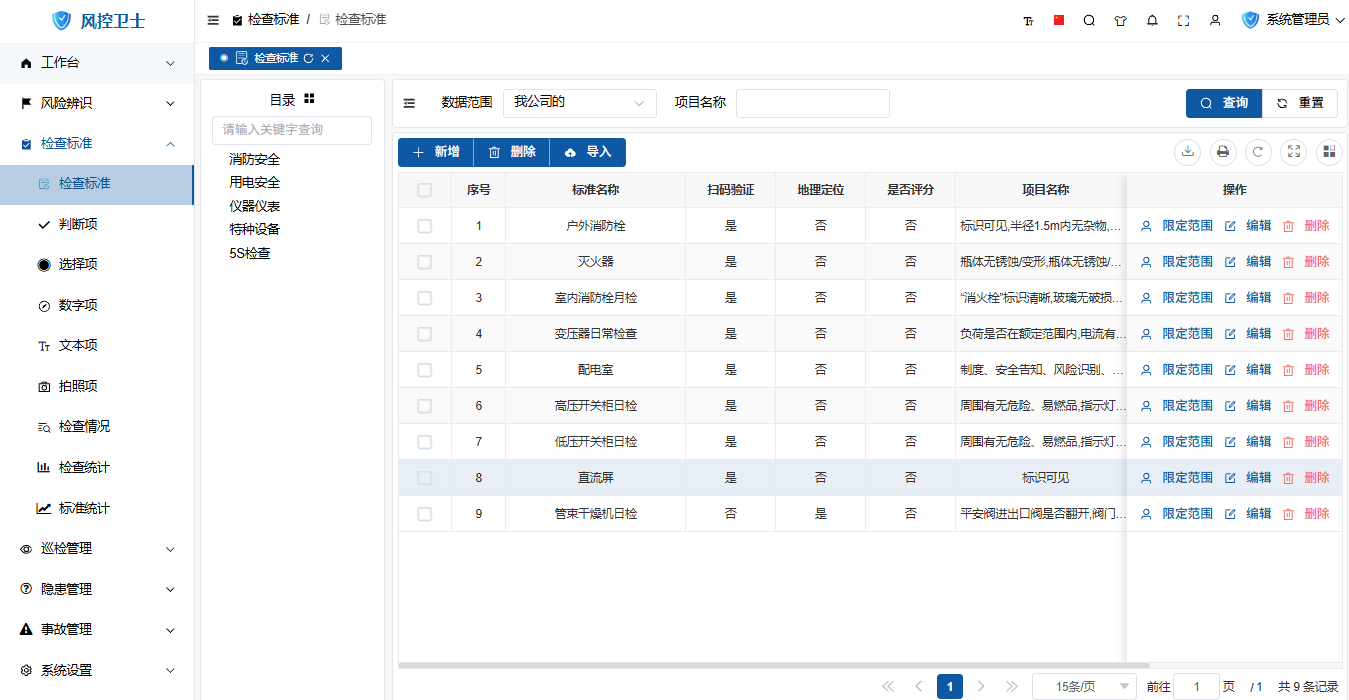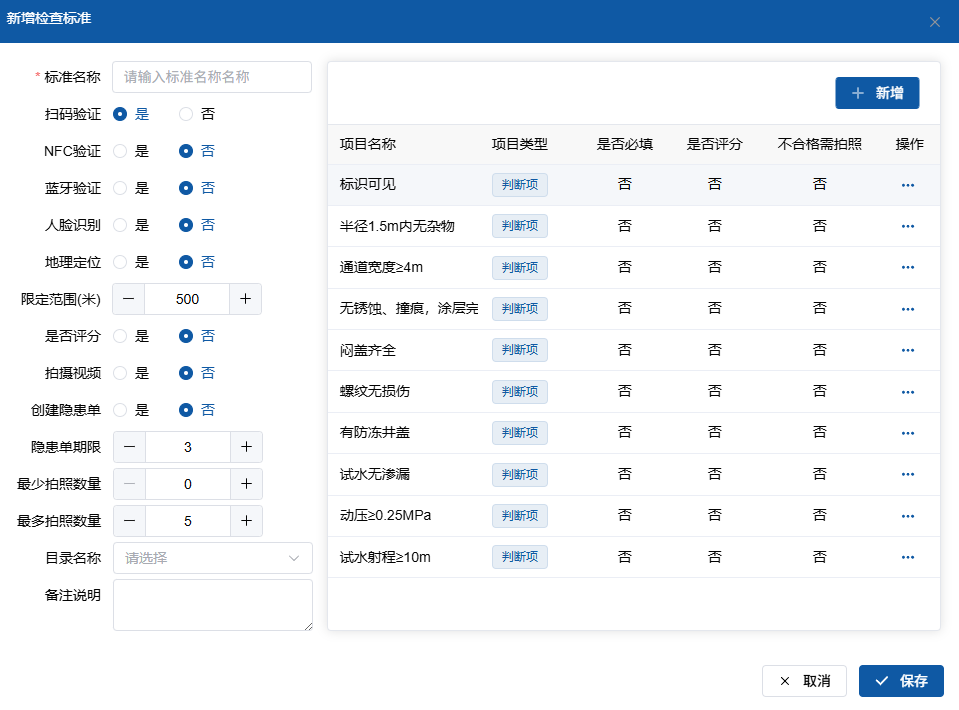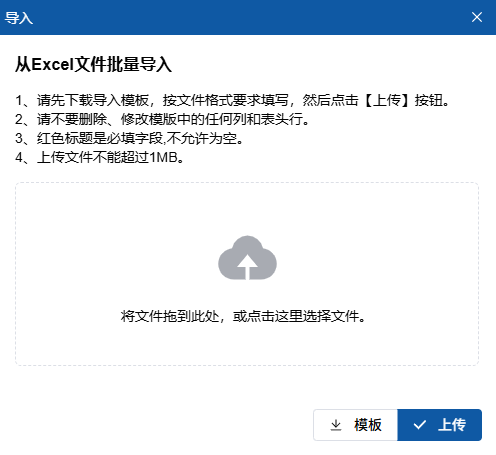How to Add New Inspection Standards
About 760 wordsAbout 3 min
I. Function Introduction
Inspection standards are the core configuration module for risk management, used to define:
- Inspection Process: Standardize inspection steps and requirements
- Verification Mechanisms: Ensure authenticity of on-site inspections
- Data Collection: Unify inspection content and format
- Risk Analysis: Establish scoring and hazard conversion rules
Core Value:
- Standardize inspection processes
- Improve data authenticity
- Automate hazard management
- Quantify risk assessment
Access Entry:
- Administrator logs into Management Backend
- Navigation menu select: 【Inspection Standards】→【Inspection Standards】

II. Single Addition
Operation Steps:
- Click "New" button on toolbar

- Configure basic information:
| Parameter | Description | Configuration Suggestions |
|---|---|---|
| Standard Name | Unique identifier | Include equipment/area information (e.g. "Daily Power Room Inspection") |
| Category Name | Classification management | Classify by business type (Electrical/Mechanical/Fire Protection) |
| Anti-counterfeiting Verification | Ensure inspection authenticity | |
| └ QR Code Verification | Requires scanning risk point QR code | Recommended for critical equipment |
| └ NFC Verification | Requires close-range NFC chip sensing | Recommended for high-risk areas |
| └ Bluetooth Verification | Requires within Bluetooth beacon range | Suitable for indoor enclosed areas |
| Identity Verification | ||
| └ Facial Recognition | Verify inspector identity | Recommended for sensitive operations |
| Location Services | ||
| └ Geolocation | Record inspection coordinates | Recommended for field inspections |
| └ Range Limit | Maximum allowed deviation (meters) | Default 500m, adjustable |
| Media Settings | ||
| └ Video Recording | Allow short video recording | Recommended for complex operations |
| └ Minimum Photos | Minimum on-site photos | Recommended ≥2 |
| └ Maximum Photos | Maximum on-site photos | Recommended ≤10 |
| Hazard Management | ||
| └ Create Hazard Ticket | Automatically generate for unqualified results | Recommended to enable |
| └ Hazard Ticket Deadline | Default processing time limit (days) | Set based on risk level |
| Scoring Settings | ||
| └ Enable Scoring | Calculate total inspection score | Recommended to enable |
- Add inspection items:
- Click "New" button on right
- Select from inspection item library:
- Judgment items (Yes/No type)
- Selection items (Multiple choice type)
- Digital items (Numerical value type)
- Text items (Descriptive type)
- Photo items (Image recording)
- Configure inspection requirements:
- Mandatory or not
- Enable scoring
- Require photo for unqualified
- Click "Save" to complete creation
III. Batch Import
Operation Steps:
- Click "Import" button on toolbar

- Download Excel template

- Fill according to specifications:
Template Filling Specifications
| Column Name | Requirement | Example | Description |
|---|---|---|---|
| Standard Name | Unique, non-repeatable | Power Room Weekly Inspection | |
| QR Code Verification | Yes/No | Yes | |
| NFC Verification | Yes/No | No | |
| Bluetooth Verification | Yes/No | No | |
| Facial Recognition | Yes/No | Yes | |
| Geolocation | Yes/No | Yes | |
| Range Limit | Number (meters) | 300 | |
| Enable Scoring | Yes/No | Yes | |
| Video Recording | Yes/No | No | |
| Create Hazard Ticket | Yes/No | Yes | |
| Hazard Ticket Deadline | Number (days) | 7 | |
| Minimum Photos | Number | 2 | |
| Maximum Photos | Number | 5 | |
| Category Name | Existing category | Electrical Inspection | |
| Inspection Item Group | Item + parameters | Equipment Temperature Detection,Yes,No,No; Pressure Gauge Reading,Yes,No,No | Semicolon ";" separates items Comma "," separates parameters |
Parameter Explanation:
Inspection item group format:Item Name,Mandatory,Enable Scoring,Require Photo for Unqualified
4. Upload and Verification
- Upload file (≤1MB)
- System automatic verification:
- Completeness of mandatory fields
- Name uniqueness
- Parameter validity
- Process error report
- Confirm import results
IV. Best Practices
1. Configuration Principles
- Verification Mechanisms:
- High-risk areas: QR code + NFC + facial recognition triple verification
- Regular areas: QR code + location dual verification
- Inspection Items:
- ≤20 items per standard
- Sort by inspection route
- Mark key items as mandatory
- Hazard Conversion:
- High-risk items: Automatically generate hazard tickets
- Medium-risk items: Warning prompts
- Low-risk items: Record without conversion
2. Scenario Configuration Examples
| Scenario Type | Verification Mechanism | Number of Items | Hazard Conversion |
|---|---|---|---|
| Daily Inspection of High-risk Equipment | QR Code + Facial Recognition | 15 items | Auto-generate for unqualified |
| Weekly Area Safety Check | QR Code + Location | 10 items | Generate for high-risk items |
| Monthly Fire Facility Inspection | NFC + Location | 8 items | Generate after manual review |
| Environmental Safety Inspection | QR Code | 5 items | Record only without generation |
V. Precautions
1. Configuration Requirements
- Naming Convention: Standard name includes area/equipment/frequency (e.g. "Daily Inspection of Zone A Power Cabinet")
- Range Settings: Limit range ≥ actual equipment impact radius
- Item Association: Key inspection items must associate with risk points
- Time Limit Settings: Hazard deadline matches risk level
2. Common Issue Handling
| Problem Type | Solution |
|---|---|
| Verification Failure | 1. Check device support 2. Calibrate location accuracy 3. Re-enter identity information |
| Item Conflict | 1. Check name uniqueness 2. Clear cache and retry 3. Manually adjust sorting |
| Import Error | 1. Check template format 2. Verify parameter range 3. Import in batches |
| Insufficient Permissions | 1. Apply for standard admin permissions 2. Contact system administrator |
3. Performance Optimization
- ≤20 inspection items per standard
- ≤3 verification methods
- ≤8 photos per inspection
